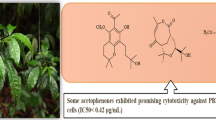Abstract
A semisynthetic β-glucosidase inhibitor was identified from a chemically engineered extract prepared by reaction with benzenesulfonyl chloride. The structure includes a natural histamine portion and a benzenesulfonyl portion introduced during the diversification step.
Similar content being viewed by others
References
Lopez SN, Ramallo IA, Gonzalez Sierra Z, Zacchino SA, Furlan RLE (2007) Chemically engineered extracts as an alternative source of bioactive natural product-like compounds. Proc Natl Acad Sci USA 104: 441–444. doi:10.1073/pnas.0608438104
Di Liberto M, Svetaz L, Furlan RLE, Zacchino SA, Delporte C, Novoa MA, Asencio M, Cassels BK (2010) Antifungal activity of saponin-rich extracts of Phytolacca dioica and of the sapogenins obtained through hydrolysis. Nat Prod Commun 5: 1013–1018
Mendez L, Salazar MO, Ramallo IA, Furlan RLE (2011) Brominated extracts as source of bioactive compounds. ACS Comb Sci. (in press). doi:10.1021/co100073k
Salazar MO, Ramallo IA, Micheloni O, Gonzalez Sierra M, Furlan RLE (2009) Chemically engineered extracts: bioactivity alteration through sulphonylation. Bioorg Med Chem Lett 19: 5067–5070. doi:10.1016/j.bmcl.2009.07.038
Lillelund VH, Jensen HH, Liang X, Bols M (2002) Recent developments of transition-state analogue glycosidase inhibitors of non-natural product origin. Chem Rev 102: 515–553. doi:10.1021/cr000433k
Wagman AS, Nuss JM (2001) Current therapies and emerging targets for the treatment of diabetes. Curr Pharm Des 7: 417–450. doi:10.2174/1381612013397915
Asano N, Kato A, Watson AA (2001) Therapeutic applications of sugar-mimicking glycosidase inhibitors. Mini Rev Med Chem 1: 145–154. doi:10.2174/1389557013407052
Wen YM, Lin X, MaCurrent ZM (2003) Exploiting new potential targets for anti-hepatitis B virus drugs. Curr Drug Targets Infect Disord 3: 241–246. doi:10.2174/1568005033481141
Robina I, Moreno-Vargas AJ, Carmona AT, Vogel P (2004) Glycosidase inhibitors as potential HIV entry inhibitors. Curr Drug Metab 5: 329–361. doi:10.2174/1389200043335513
Asano N, Kizu H, Oseki K, Tomioka E, Matsui K, Okamoto M, Babat M (1995) N-alkylated nitrogen-in-the-ring sugars: conformational basis of inhibition of glycosidases and HW-1 replication. J Med Chem 38: 2349–2356. doi:10.1021/jm00013a012
Marston A, Kissling J, Hostettmann K (2002) A rapid TLC bioautographic method for the detection of acetylcholinesterase and butyrylcholinesterase inhibitors in plants. Phytochem Anal 13: 51–54. doi:10.1002/pca.623
Ramallo IA, Zacchino SA, Furlan RLE (2006) Autographic method for the detection of xanthine oxidase inhibitors and superoxide scavengers. Phytochem Anal 17: 15–19. doi:10.1002/pca.874
Salazar MO, Furlan RLE (2007) Autographic method for the detection of glucosidase inhibitors. Phytochem Anal 18: 209–212. doi:10.1002/pca.971
Emmelin N, Feldberg W (1947) The mechanism of the sting of the common nettle (Urtica urens). J Physiol 106: 440–455
Field RA, Haines AH, Chrystal EJT, Luszniak MC (1991) Histidines, histamines and imidazoles as glycosidase inhibitors. Biochem J 274: 885–889
Magdolen P, Vasella A (2005) Monocyclic, substituted imidazoles as glycosidase inhibitors. Helv Chim Acta 88: 2454–2469. doi:10.1021/jm800512z
Li YK, Hsu HS, Chang LF, Chen G (1998) New imidazoles as probes of the active site topology and potent inhibitors of b-glucosidase. J Biochem 123: 416–422
Wrodnigg TM, Diness F, Gruber C, Häusler H, Lundt I, Rupitz K, Steiner AJ, Stütz AE, Tarling CA., Withers SG, Wölfler H. (2004) Probing the aglycon binding site of a beta-glucosidase: a collection of C-1-modified 2,5-dideoxy-2,5-imino-D-mannitol derivatives and their structure-activity relationships as competitive inhibitors. Bioorg Med Chem 12: 3485–3495. doi:10.1016/j.bmc.2004.04.037
Viant MR (2003) Improved methods for the acquisition and interpretation of NMR metabolomic data. Biochem Biophys Res Commun 310: 943–948. doi:10.1016/j.bbrc.2003.09.092
Daszykowski M, Serneels S, Kaczmarek K, Van Espen P, Croux C, Walczak B (2007) TOMCAT: a MATLAB toolbox for multivariate calibration techniques. Chemom Intell Lab Syst 85: 269–277. doi:10.1016/j.chemolab.2006.03.006
Author information
Authors and Affiliations
Corresponding author
Rights and permissions
About this article
Cite this article
Salazar, M.O., Micheloni, O., Escalante, A.M. et al. Discovery of a β-glucosidase inhibitor from a chemically engineered extract prepared through sulfonylation. Mol Divers 15, 713–719 (2011). https://doi.org/10.1007/s11030-010-9301-2
Received:
Accepted:
Published:
Issue Date:
DOI: https://doi.org/10.1007/s11030-010-9301-2




